 KToY banquet trophy & program. Tonight was the state awards banquet for Kansas Teacher of the Year in Wichita, Kansas. I was one of eight finalists statewide recognize for that achievement, the only one of whom was male, which has become a point of humor more than once already.
As a finalist for Kansas Teacher of the Year, I will now have the opportunity to join with the other finalists at numerous appearances to advocate for the teaching profession, as well as working with current and preservice educators, across the state of Kansas. I look forward to the opportunities to speak with legislators, administrators, and community members across the state as part of this program.
Having met and spoke with teachers who have already been part of this program in the past, I have had the chance to see what a substantial impact being a finalist for Teacher of the Year can have on one's teaching styles.
As part of the banquet tonight, time was given to introduce each of the finalist teachers and describe some of the characteristics that made them suitable for finalist for Kansas Teacher of the Year. After their introduction, time was given for each teacher to make some remarks about their role in education, their experiences in teaching, or what a typical day in their classroom might look like. Below, please find the comments I made in my time to expound upon my teaching experiences and what led me to choose a career in the teaching profession.
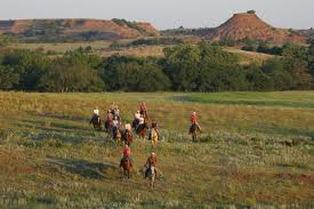 Gypsum Hills, south-central Kansas After having the opportunity to work as a teacher's aide as a junior in high school, I'd found a career path. Tiger Woods would have to hold things down on the PGA Tour himself. I was abandoning that pursuit to become a math teacher. I had the opportunity with a summer job to work alongside Mr. Ferguson and Vern, a pair of my teachers I learned under just a few years before. We were setting roof joists on a shelter house in the Gypsum Hills of southern Kansas. As we worked, I had an opportunity to talk about my career path with Vern (Mr. Buell was far too formal a term for him to accept), my legendary and influential math teacher during my sophomore year. He didn't exactly share the secret of life, but made a funny comment about Mr. Ferguson, the social studies teacher who was working on the roof with us. He said "Now, Max is a social studies teacher, so we have to talk a little slower with all our measurin' so he can keep up." With a few years teaching experience now under my belt, I'd like to try and paraphrase that comment: Teachers are all in this together. We can't just focus solely on how well a student can write a summary paper, or map out a chemical reaction, or solve an equation involving some really intimidating-looking fractions.
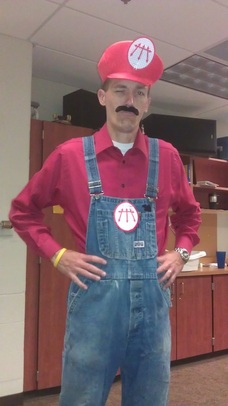 My alter-ego, Slope-R Mario. So now, in my classroom, we work to incorporate real-life experiences with students to make topics much more engaging and long-lasting than a bunch of numbers on a textbook page. It might involve creating a giant Jenga game made from 2 x 6's, or creating a Sierpinski triangle out of pennies in the school parking lot, or how we determined if students' backpacks were a tolerable weight by doctors' recommendations, or even result in my wearing overalls and a fake moustache to take on the persona of Super Mario so students get the topic of slope. Regardless of their topic, time, or trade, I strive to make learning relevant to my students, whatever their background or career path. Learning experiences among my students can read almost like a collection of inside jokes, where "you had to be there." With the mentality that "we have fun, but we get stuff done," students take with them a collection of experiences we shared together. I do have to admit, about a year ago when I had the chance to work on the Extreme Makeover: Home Edition house outside of Ottawa, Kansas, I was taken back to that day on the roof with Mr. Ferguson and Vern. I found myself working again on roofing joists, just down the wall from a pair of men who were working on the same task. When I heard them bickering about fractions and how to properly space some beams, I was ready to help them out. But like Vern said, I had to make sure to talk a little slower with all the measurin' so they could keep up."Thank you.____________________________ I hope you look forward to hearing about my adventures as a part of the Kansas Teacher of the Year Team as much as I look forward to sharing them. Stay tuned. --Keltner--
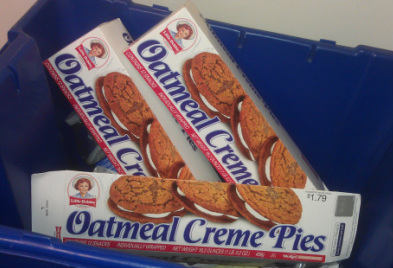 The "after-math" of introducing systems of equations. Delicious pun, huh? Introducing systems of equations about the same time of year as Halloween candy flows freely can be dangerous. I tried to use students' sugar cravings to introduce the topic in class though. I have a sweet spot for Little Debbie's Oatmeal Creme Pies and noticed a peculiar pricing setup betwixt their Single Decker and Double Decker snacks. At a budget-friendly price, I was able to bring snacks for my students to help solidify their work on the example we posed to introduce systems of linear equations. Gimmicky, I know, but it definitely grabbed their attention, wondering why I brought snacks that day.
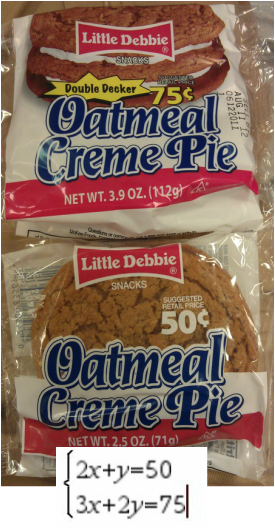 The rest of the example relied heavily on the photo at left, which showed two different "recipes" of Oatmeal Creme Pies available at our local convenience store, one the traditional Single-Layer-O'-Creme and the other the legendary Double Decker. This gave students a familiar context and placement of the example and led to a pretty casual conversation that was more engaging than cracking open the textbook, without a doubt. We investigated several things about the snacks: - Does the weight matter for the price (hinting at a use of direct variation which we had studied previously)?
- What are the things about the snacks we CAN change and which things are non-negotiable? (i.e. what are our variables and our constants in this scenario? I was proud they got this outlined so quickly.)
- Is there a more efficient way to solve for the cost per cookie layer and cost per creme layer?
So, with hook baited, we entered into the strategies for solving linear systems of equations, notably in this instance the substitution method. We set up the system of equations at the bottom of the graphic at left and solved, arriving at an astonishing revelation: The creme layer costs ZERO cents!(The cookie layer costs twenty-five cents, as we discovered.)Students had a hard time wrapping their heads around this, thinking more of the context or production costs until another classmate emphasized that our goal was to figure out the PRICE for each cookie and creme layer, not the COST.This was a decent introduction to the idea of a solution for a system of equations, because students emphasized to one another that zero cents for a creme layer did not make much sense on the surface, but the pricing structure we solved for WORKED with the label price of each snack (made a true statement). When I had to back up and give a concrete definition for what a solution to a system is, students had already seen it used in context and had a more concrete understanding of how it worked in the abstract sense of the topic.I hope you enjoy this example as much as my students did. Without a doubt, timing during the school day was critical with this example. Oh, a side note: I did not use the Oatmeal Creme Pies as pictured; I bought 12-packs that were a bit smaller but still grabbed students' attention just as well. For now, I need to run. Just reflecting on this lesson is making me hungry.
--Keltner--
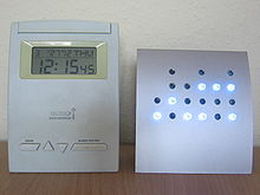 Students grew curious of this binary clock. A student approached me last week about a clock he had seen online, a binary clock (Link redirects to ThinkGeek where it was originally discovered) and was curious about how it could be read. I was able to fall back on a worksheet I created my first year of teaching, meant to be sort of a reading assignment (because at that time, our building was focusing on reading comprehension among our students). Granted, I definitely need to edit this lesson and include some better images and examples, as well as expanding upon the idea of how to "carry digits" when working in a base-2 system. Most of the emphasis on the worksheet is placed on how to convert from base-2 (binary) to base-10 (decimal) and vice versa though.
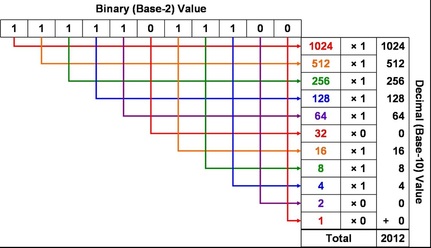 My new, edited visual aid to convert from base-2 to base-10. I've modified the table/chart from my worksheet mentioned earlier to the one at left. Our students attended Math Day at Emporia State University (my alma mater) on Ocotber 31, and one of the questions during the competition was: "Write 2012 in binary form."Luckily, my students had access to a TI-Nspire CX CAS which has a quick function to allow them to make the conversion, but they came away from the contest wanting to know more about how binary numbers work and if other similar systems exist. Another crowning achievement through all this discussion is that students understand the t-shirt design I have posted at the back of my classroom that says "There are 10 types of people in the world: those who understand binary and those who don't."--Keltner--
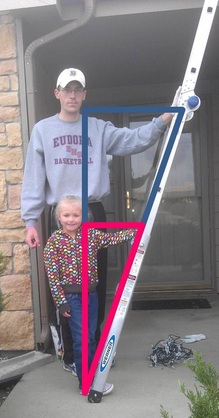 I am not of Griswold heritage, thank you. Yup, I'm "that guy" in the neighborhood who puts up Christmas lights on the house the weekend after Halloween. Contrary to popular belief, though, I do it out of planning for inclement weather conditions that seem to come soon after November begins. While my daughters appreciate seeing our lights on, they also enjoy helping out with putting them on the house. Hence, the picture at left of my second daughter and I, properly footing a ladder. That's a term I learned through my firefighter classes, and also learned the proper angle for ground ladders of this type. The rule of thumb for proper ladder angle says: - If you can stand at the base of the ladder and reach out to the rung directly in front of your shoulder, the ladder is at a proper angle if you touch somewhere on the palm of your hand (to allow a little bit of room for error).
- If the ladder is positioned somewhere on your forearm, it is too steep and poses a safety hazard.
- If the ladder is so shallow that your fingers cannot reach it, the ladder will flex under the weight of the user and increase the potential for collapse of gutters or other objects at the other end of the ladder.
So I made sure to superimpose figures on the photo of me and wee-me to display the similar triangles that occur, but also to show the relationship of slope and how it relates to three collinear points along the ladder. [NOTE: The fact that my arm and duaghter's arm are not fully extended is due to the fact we stood PRECISELY at the base of the ladder instead of lining up our toes with the base. This was because I wanted to illustrate the slope more directly and not have to account for shoe size, although we both wear size 11 right now, just different categories.]
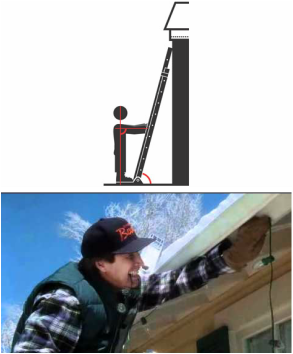 Proper Ladder Angle should be at a 4-to-1 ratio (slope). The diagram at left also illustrates proper ladder angle, but does not include the ladder extending above the surface it is leaning on. The other feature I must point out is the user's feet are AT the ladder's feet, not lined up at the ankle's as my daughter's and my ankles were in the photo above.
While I'm not dwelling on a whole lot of math within this post, there are a lot of different directions a teacher can go with this: similar triangles and slope are just a sample.
Moreover, I would hope you get a little grin on your face as the holiday season arrives in the coming days, weeks, and month(s).
We definitely have a hefty glow at our house now. And yes, our lights did work the first time I plugged them in.
--Keltner--
|









 RSS Feed
RSS Feed